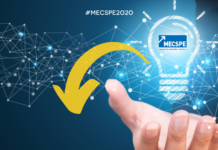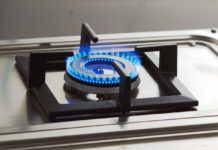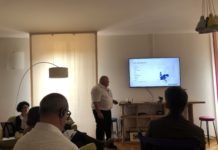The collaboration between the Italian Institute of Technology, Milan Polytechnics and Omet has given birth to the silicon-free photovoltaic cell, obtained through a layer printing process on common Pet. Target, recovering and reusing the “lost” energy of the indoor lighting.

A “green” photovoltaic skin. Almost fully recyclable, cheap, light and flexible. Able to capture and to make the light energy usable in an indoor environment to power the operation of sensors, from the domotic house to the office, from the public building to the big shopping centre, helping to manage the performances of the interior space. It springs from the collaboration between IIT (Italian Institute of Technology), Milan Polytechnics- Lecco headquarters- and Omet, company specialized in the sector of printing and tissue converting, the new prototype of silicon-free photovoltaic cell obtained through a layer printing process on common Pet, the polyethylene used for the production of bottles for drinking water. The product is going to enter the market within the next triennium, thanks to the establishment of a dedicated start up, Ribes Technologies, which benefits from the heritage of four years of work in laboratory.
Integration with design
The technology of these photovoltaic cells is based on organic semiconductor materials like some types of special polymers able to conduct the electrical charge and then to assume a conductive or semi-conductive behaviour. Exploiting polymeric materials, the modules do not include toxic substances or rare materials used in the field of the other photovoltaic technologies (like precisely the silicon of standard panels) and enhance, on the contrary, the compatibility with the typical disposal and recycling methods of plastic materials.
The operation principle of these photovoltaic modules strictly resembles the one of a silicon cell, from which they differ since they consist of different superimposed layers, deposited with printing techniques deriving from graphic arts. The use and application versatility stands out as the most interesting function: the photovoltaic modules so implemented consist of subtle, flexible and very light films, they can be easily manufactured with different shapes and colours, suiting the design requirements of the objects into which they can be integrated.

The research project starts from the first contacts between the academic and research world with Omet company, with the creation of a joint laboratory where have converged skills, study experiences and technological innovation. “The research on these materials started several years ago and ten years ago they began to develop a research course with interesting applications for small cells of indoor application – states Guglielmo Lanzani, professor of Physics of Milan Polytechnics and director of the Nano Science & Technology Centre of IIT -. For one year and a half, we have been able to produce prototypes, now the pursued direction is to work to increase the efficiency and then the application field”. The state-of-the-art photovoltaic cell, fruit of this project “is a clean, cheap and easily implemented product, comfortably integrated into various device types, with a very short payback time. Besides, it costs less and has a minor impact on the environment since it needs less energy for production, it is easily disposed and provides for the use of less material. The idea of applying it in indoor environment allows, in particular, recovering the emitted light and making it usable for the operation of small devices”.
From the design to the start up
Ecologic and recyclable are two of the adjectives that characterize the new photovoltaic cells, with a broad range of usable materials. “We started with the use of PET but likewise we might use the photographic paper or another type of plastic, with perfectly smooth and planar surface allowing the printing process” explains Antonio Iacchetti, researcher of the Nano Science & Technology Centre and Managing Director of the start-up. Special, highly innovative plastics, for instance, able to conduct the electrical charge or to be semi-conductors, which we buy from other start up enterprises that in their turn are beginning to market their product”. The indoor is the priority application field. “Considering that standard photovoltaic cells show a neat efficiency drop in typical indoor conditions, characterized by low light intensity, lighting through diffused light, LED or fluorescence lamps, in this specific application ambit, the efficiencies of our devices do not differ a lot from silicon ones, being equal to 3%. Lit up with artificial light, our modules can generate some dozen microwatts per square centimetre”. The other great requisite that opens interesting application scenarios of these cells is their high adaptability and, in prospect, the drastic reduction of management and maintenance costs, replacing the conventional power batteries for sensors and other devices. “These films can be printed with utmost shape freedom for the application in the field of electronic sensors, of domotics and more in general of the Internet of Things world, transforming the surface of sensors into an active element that generates the necessary energy for their operation, varying the absorption of the photovoltaic cell to suit the specific lighting spectrum and then to optimize efficiency”.

The start-up is entrusted with the peculiar task of bringing to steady state the industrialized process based on in-line printers for the product marketing. Development prospects are not missing. “Actually, something similar does not exist on the market today but we notice a great interest of companies operating in domotic ambit, from lifts to localization nets for interiors based on sensors that detect the position and communicate data with wireless device needing power supply. Up to the sector of electronic labels of supermarkets that currently need batteries”. Not only. “Another long-term goal consists in coupling this technology with small electronic circuits, they too plastic, to bring functions on surfaces that presently have not them. For this reason, we have patented the process to obtain a plastic fully recyclable sheet, constituting a dynamic label that can flash or change state, indicating for instance the conservation condition of a food or a beverage, or if the refrigerator door was left open”.
Nose for innovation
The partnership between research world and business world is at the base of the success of the project resulted in the innovative prototype of photovoltaic cell. A strong bent for innovation that Omet Group, headquarters in Lecco, three business units specialized in printing sectors (production of narrow and mid web platform machines for labels and packaging printing), tissue converting (manufacturing of automated machines for the production of disposable napkins and towels), and handling (production and testing of bearing handling systems), highlights as characterizing element of its fifty-year industrial history. “Our culture has always led us to search for different innovation ambits where to apply our competences and to develop researches and experimentations – explains Antonio Bartesaghi, owner of Omet -. In the printed electronics field, we collaborate with various universities abroad, especially in Canada and United States and from this world has come the idea of undertaking the production of photovoltaic cells obtained from a printing process. Experimentation started thanks to the meeting with the Italian Institute of Technology and Milan Polytechnics”. For this project, Omet has made available a printing machine manufactured by them, to which in time they have made the opportune changes to meet new manufacturing requirements, and the technical support with the corporate research and development laboratory. The successive step, in course, is the participation in the industrial, and commercial, promotion of the product. “Omet is an important part in the start-up, we intend to go on investing and working so that this project gives birth to the industrialized product”. The printing technologies of electronic elements and components are constantly and rapidly evolving: “The number and the quantity of objects that we will be able to obtain from this innovative work method will be numerous in the future, we think, for instance, of the possibility of attaining light luminous elements and light sources with the same layer printing process”.




